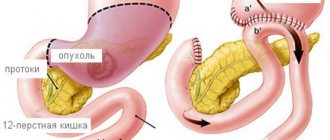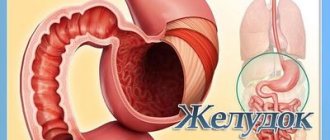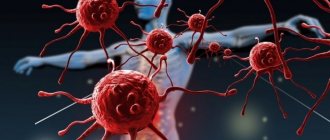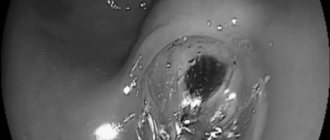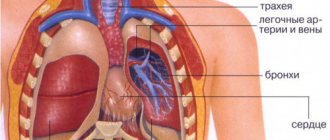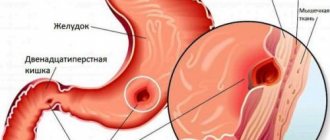The stomach and the processes occurring in it
The stomach can change its shape depending on the amount of food consumed.
When empty, the volume of the stomach is approximately 0.5 liters, with a length of 18-20 cm. The walls, back and front, are shifted, almost touching each other. As the stomach fills, it expands to one and a half liters. The walls are moved to a distance of 8-10 cm from each other. This is within normal limits.
In case of overeating, the stomach can expand to a volume of 3 liters. There are known cases of stretching up to 4l. The size of this organ depends on the height and build of a person, on his nutritional culture, that is, on how, what, and how much food he consumes daily.
Despite its apparent simplicity, the stomach is a rather complex organ, the walls of which contain numerous and varied glands, endocrine cells involved in the work of the whole organism. The gastric mucosa produces gastric juice, which saturates food coming from outside and performs the first stage of its breakdown into various components. During the day, up to 2 liters of gastric juice are produced. An important place in this process is occupied by hydrochloric acid, a chemical active substance. Hydrochloric acid performs the following functions in the body:
- interacts with protein, breaking it down into components,
- destroys harmful organisms that enter the stomach along with food,
- Converts ferrous iron to ferric iron, which is necessary for the formation of blood.
Gastric juice also produces enzymes involved in the breakdown of proteins and fats, and mucus, which lines the walls of the stomach and protects it from the aggressive environment of HCl. Mucus produced during digestion also protects the stomach from self-digestion. Gastric juice begins to be produced before eating. This is facilitated by the smell of food, its appearance, and thoughts about food. Equally important is the time corresponding to the time of eating. This is why it is also so important that a person always eats at the same time.
The production of gastric juice contributes to the appearance of appetite, that is, the need for food.
Lazy stomach syndrome
Today, every third resident of the country faces gastric dyspepsia, but for few people this becomes a reason to consult a doctor. Why the stomach slows down and what needs to be done to get rid of unpleasant symptoms, says Ayagoz Eskozhina, a gastroenterologist of the highest category at the North Kazakhstan Regional Hospital.
— The word “dyspepsia” translated from Greek means “impaired digestion.” Gastric dyspepsia is a set of symptoms that occur when the digestion of food in the stomach is disrupted and its emptying slows down. There is also intestinal dyspepsia - a violation of the digestive function of the intestines.
What symptoms are characteristic of gastric dyspepsia?
— The digestion process normally should not be accompanied by any unpleasant sensations. Of course, if a person is bothered by the feeling of fullness in the stomach due to the fact that he has overeaten or consumed carbonated drinks, then the state of the digestive system has nothing to do with it. Short-term belching of air, without any unpleasant odor, is not a reason to panic; it is also a normal physiological process.
But if, after a regular portion of food, it seems that the stomach is full, the stomach is bloated, a feeling of fullness quickly sets in, and all this is accompanied by belching or a bitter, rotten or sour taste, then there are disturbances in the functioning of the digestive tract. In addition, depending on the causes, symptoms of gastric dyspepsia may include heartburn, nausea, vomiting, diarrhea, flatulence, constipation, night hunger pain in the stomach.
Most often, dyspepsia occurs at a young age, up to forty years.
For what reasons does the stomach slow down?
— Dyspepsia occurs not only with stomach diseases, but can also be caused by disorders in other organs and systems.
The cause of most of the symptoms that we attribute to gastric dyspepsia is a violation of the motor function of the gastrointestinal tract, that is, most often it is functional dyspepsia. The stomach “refuses” to contract, this complicates the process of digesting food and causes all sorts of unpleasant sensations. Therefore, such gastric dyspepsia is also called “lazy stomach syndrome.”
If dyspepsia is accompanied not only by dysfunction, but is also associated with damage to the gastrointestinal tract, then it is organic dyspepsia.
The disorder can be caused and associated with diseases of the digestive system such as peptic ulcer of the stomach and duodenum, pancreatitis, cholecystitis, tumors, liver disease, cholelithiasis; vascular diseases, coronary heart disease, diabetes mellitus and disorders of the thyroid gland, diseases of the nervous, respiratory, genitourinary systems, cancer, the bacterium Helicobacter pylori, which damages the walls of the stomach and intestines, as well as taking antibiotics and some other medications, drinking alcohol, smoking.
Gastric dyspepsia can be inherited or be a consequence of stress.
In addition, there is nutritional dyspepsia associated with nutritional disorders, when the ratio of proteins, fats and carbohydrates consumed in food does not correspond to the norm. If carbohydrates (bread, sugar, legumes, fruits) predominate in the diet, a person consumes a lot of kvass and beer, and fermentative dyspepsia occurs. Insufficient chewing of food also contributes to it.
With an excess of fat, especially lamb and pork, fatty or soapy dyspepsia occurs.
If a person eats mainly protein foods (meat, eggs), especially if these products are stale, then putrefactive dyspepsia may develop.
Dyspepsia can also be caused by a deficiency of enzymes necessary for digesting food.
There are so many causes and symptoms, they are similar to signs of many diseases, what examinations will be needed to make an accurate diagnosis?
— To establish what kind of disturbance in the functioning of the digestive system caused the problems we have named, an endoscopic examination of the stomach and duodenum, an ultrasound, perhaps a computed tomography and, of course, blood and stool tests may be necessary.
When making a diagnosis, it is important to know how long the pain and other symptoms have been going on, under what circumstances they occur, and what diseases already exist. Therefore, all you need to do is consult a doctor, follow his recommendations, treat diseases that may be associated with dyspepsia, and after treatment continue to eat properly so that unpleasant symptoms do not return.
Perhaps, in addition to a therapist or gastroenterologist, the patient will also need a consultation with a psychotherapist.
How should a patient with gastric dyspepsia eat?
— It is recommended that everyone eat frequently, in small portions, at the same time, chewing food thoroughly. Then the stomach gets used to a certain operating mode and “works” without failures. The last meal should be no later than two hours before bedtime, so as not to provoke putrefactive dyspepsia.
Eat in a relaxed environment, without being distracted by the computer or TV.
Nutrition should be balanced, from fresh and high-quality products. Do not abuse fatty foods, chocolate, carbonated drinks, canned food, and alcohol.
If signs of dyspepsia appear, limit the consumption of citrus fruits, coffee, strong tea, too salty or sweet, spicy, smoked, fried - all this provokes heartburn.
Also, during treatment you will have to give up yeast baked goods, raw vegetables and fruits and their juices, tomato paste, and rice. The menu must include first courses, the food must be warm.
In case of nutritional dyspepsia, restrictions also apply to the “culprits” of dyspepsia. That is, with fermentative dyspepsia, you cannot eat foods rich in carbohydrates; you will have to give preference to protein foods - cottage cheese, boiled meat and fish, fish soup, broth.
In case of putrefactive dyspepsia, on the contrary, proteins are limited, but apples, cereal soups and decoctions, and crackers are recommended. The return to meat products should be gradual, starting with low-fat varieties.
For soapy dyspepsia, animal fats are replaced with vegetable fats, which should also be small.
What else can you recommend, besides dietary restrictions? Maybe there are some therapeutic doses of physical activity?
— It is very useful to walk for at least half an hour after eating, but it is better not to do exercises that train the abdominal muscles if you have symptoms of dyspepsia. You should not tighten your belt too tightly.
And don’t forget that many diseases can be avoided if you lead a healthy lifestyle, eat right, and learn to cope with stress.
Inna Kalimbet
Petropavlovsk
What should an adult eat?
An adult's diet should include proteins, fats, and carbohydrates.
For normal functioning of an adult body, it must receive daily:
- Water. The human body is 80 percent water. Water is life. It is found in the tissues and cells of our body, in the blood; water helps remove toxins from the body. Water should be drunk not only in tea, coffee or juices. The body must receive clean, preferably unboiled water.
- Proteins are a source of material that serves to build body cells. Proteins are of plant and animal origin. They are found in meat, eggs, dairy products, legumes and grains.
- Fats are a source of concentrated energy. They can remain in the body for a long time in the form of fat deposits. Sources of fats are vegetable oils, lard, animal fat, and butter. And some high-fat dairy products.
- Carbohydrates are a source of energy that is immediately consumed by the body. True, if a person leads a sedentary lifestyle or consumes them in increased quantities, carbohydrates can also be converted into fat deposits.
- Antioxidant vitamins, nicotinic and other acids are necessary for the body to function normally and are found in almost all foods, especially in vegetables and fruits.
Microelements are involved in the construction of bones, hair structure, and other tissues, in the formation of blood and nerve cells. They are found in all products.
How to shrink your stomach and lose weight
To reduce the size of your stomach, you can reduce the amount of food you eat.
In order for all the above components to enter the stomach, the diet must be varied. The daily menu may include various cereals, soups, pasta, borscht, stewed vegetables, fresh vegetable salads, meat, fish, etc.
Read: Where is the stomach: location, structure and functions in the body
The question is - how much? Each person decides for himself individually. Someone eats a lot, does not gain weight, and does not suffer from it. Some people eat little and don’t lose weight. Much depends on individual vital activity, on the energy consumption of a particular organism.
But let's return to the stomach. How much can it hold? As practice shows, up to 3 liters. But is it necessary to overload it like that? Let's calculate how much the average Russian eats for lunch. A plate of borscht or soup – 300 grams. Another 250 grams will be the second, 100 grams - bread. 650-700 grams is half the stomach full. And that's enough. This is the norm that doctors constantly repeat. Traditional healers echo them, persuading us not to overeat. Compote, jelly or cocoa, that is, the third, you can drink about two hours later, as an afternoon snack.
Most nutritionists believe that breakfast should be hearty. What does tight mean? Should I eat more? Organize your breakfast according to the principle: less is more. In other words, make your breakfast energy-rich. Let the food be smaller in volume so as not to waste extra energy carrying a heaviness in the stomach. But energetic. A difficult working day lies ahead. You need concentration and physical strength. A buttered bun with a banana on top wouldn't hurt here; or a cake, a piece of chocolate or a chocolate candy.
It's great if you have walnuts in your diet. This is a charge for the whole day. Do you like salads? Please. But only from sweet fruits and sour cream. Save your diet cabbage salads for the evening. So in the morning you will eat no more than 350 grams (counting tea or coffee), and recharge your energy. By the way, hot drinks in the morning help the body warm up and invigorate.
Snacks are not forbidden, but this does not mean that you have to run to the refrigerator every half hour. Have one snack between breakfast and lunch. And one - between lunch and dinner.
This can be a saucer of vinaigrette or a nutritious salad, but not more than 100 grams. Between lunch and dinner, the snack should be light in calories. Fruits, a glass of juice, vegetable salad. And for dinner, it is advisable to reduce proteins, fats and carbohydrates to a minimum. Let it be salads and fruit juices with light bran bread. And also no more than 300 grams. Help your body get ready for the coming sleep.
Read: Anatomy: where is the human stomach located, what functions does it perform?
Foreign body in the stomach - symptoms and treatment
The disease code according to the International Classification of Diseases (ICD-10) is T18.2.
There are various classifications of foreign bodies in the stomach. For example, the European Society of Gastrointestinal Endoscopy proposes to subdivide them according to radiopacity and type of object [6].
Foreign bodies according to the degree of radiopacity:
- radiopaque - dense inedible objects, such as metal, dentures, teeth;
- non-radiopaque - fish and bird bones, wood, plastic, glass.
By type of foreign body:
- blunt-ended - coins, buttons, magnets, batteries;
- pointed - pins, needles, toothpicks, fragments of dentures;
- long objects - soft (lace, rope) and hard (cutlery, screwdriver, pen, pencil);
- bezoars are food boluss with or without bones;
- other objects - for example, containers with prohibited substances.
In Russia, foreign bodies are classified according to the degree of aggressiveness and the nature of the impact:
- Inert - are freely located in the lumen of the stomach and do not affect its wall (small toys, construction parts).
- Aggressive - negatively affects the stomach wall. The following types of impacts are distinguished:
- chemical - cause chemical and thermal burns of the stomach wall (batteries);
- physical - they compress the walls of the stomach (magnets);
- mechanical - damage the wall of the stomach (needles, pins, screws);
- combined (bezoars, silica gel beads) [1].
Inert foreign bodies, once in the stomach, move unhindered to the rectum. Patients complain that they have swallowed a foreign object, but there may be no painful symptoms.
Chemically aggressive foreign bodies cause a burn to the stomach wall and destroy the protective mucous layer. Despite the fact that the gastric mucosa is completely renewed within 3–5 days, with prolonged exposure deep ulcers and perforations can form. Patients complain of sharp pain in the upper abdomen, nausea, vomiting and discoloration of stool, especially when swallowing a battery. A chemical burn to the stomach can be caused by alkali or acid. An alkaline burn will be deep, and an acid burn will be superficial, since alkali is more active. It acts on the walls of the stomach until it is neutralized [14].
A striking example of physically aggressive foreign bodies is the magnetic balls of the Neocub constructor. They have strong magnetism and, having entered the stomach at the same time, stick to each other and pass as a single object. But after 30–40 minutes, it is enough to swallow another ball so that the wall of the stomach and small intestine becomes sandwiched between it and the previous portion that has passed further through the intestines. In places of compression, blood flow worsens and tissue gradually dies, which leads to perforation. Patients complain of a metallic taste and pain in the upper abdomen. The pain intensifies with perforation and becomes cutting and unbearable.
Mechanically aggressive foreign bodies most often lead to shallow damage. Thanks to the needle reflex, sharp objects turn over with the blunt end first and leave the body. However, despite this reflex, there are cases of perforation of the stomach wall and peritonitis. The main symptom will be acute pain in the upper abdomen.
Foreign bodies with combined effects include bezoars and silica gel beads. Bezoars are formed in the stomach or intestines from undigested food debris, hair, resins, and blood clots. Their formation resembles felting - active peristalsis compresses the remains of undigested food.
Depending on the filling there are:
- A trichobezoar is a felted ball of hair that can weigh up to 1.7 kg, occupying the entire space of the stomach. They are more common in people with impaired psychological adaptation who eat their hair when stressed.
- Phytobezoar is a lump of undigested fiber from fruits and vegetables, berry seeds, and product resins that are not destroyed by gastric juice.
- Stibobesoar is formed from undigested remains of animal food, mainly fats. They are rare and are formed if a person eats a lot of goat or lamb fat.
In addition to the mechanical impact due to their large size, bezoars cause chemical burns. Therefore, the clinical picture will be mixed - as when swallowing chemically and mechanically active foreign bodies.
The vicious circle of overeating
Constant overeating leads to an enlarged stomach and food addiction.
Dense and plentiful food that overwhelms the stomach leads to difficulty breathing, the enlarged stomach puts pressure on the lungs, on the heart, resulting in rapid heartbeat, shortness of breath, and fatigue. From below, the stomach compresses the liver, a stabbing pain appears in the side, puts pressure on the hematopoietic organ - the spleen, the blood begins to move more slowly through the veins, and the person becomes sleepy.
If a person does not work, then it is quite natural for him to try to take a nap after a hearty lunch. The energy received along with fats and carbohydrates is not consumed, but is stored in fat. As a result of regular overeating, the muscle tissue of the stomach stretches and stops contracting, the stomach enlarges and requires more and more food, the person gains weight and becomes fat.
He finds himself in a vicious circle: the more he eats, the more his stomach stretches, the more food he requires. The more he eats, the less he moves, and the more fat he gets, the more he wants to eat. And sleep. People who have retired or office workers who lead a sedentary lifestyle usually fall into this vicious circle. Sometimes stress leads to this condition. A person must break this vicious circle himself.
Where to begin? You need to start by taking a beaker or a 200 gram glass. Count how much you eat at one time. This can be done simply by pouring water into the container with which you eat. The water will show you how much food your plate can hold. Have your measurements shown that you eat much more than what is written above? And now it seems to you that by consuming only the specified amount of food, you will die of hunger?
The volume of the stomach also depends on the age of the person.
Start reducing your portions gradually. 30-50 grams daily. Keep a diary and write down for yourself how much and what you ate. Secondly, stop sleeping after lunch. Do you want to sleep? Look around, there’s probably something waiting in the house, waiting for you to clean, repair, and put it in order. Are you a wonderful host and everything is fine with you? Amazing. Go out and take a walk. A half-hour walk will discourage the desire to sleep.
Read: Where is the stomach: location, structure and functions in the body
If you are not working, try to find something to do: working on a plot of land, carpentry, cars - this is for men. Keep yourself busy with something - it will help you use your energy productively and take your mind off the refrigerator. And it may even bring in some money, at least for gifts for grandchildren. Practice shows that increasing physical activity and working in the house even for 2 hours allows you to burn up to 5 kg. in Week.
Electrical appliances have greatly simplified our lives. We stopped doing laundry, washing dishes, and cleaning the floor. All this is done by smart machines. On the one hand, this is good. But it's good for a really busy, working woman. People began to move less. And man was created for movement, for creation. And it’s good when he has a favorite activity for which smart machines free him. But often this does not happen, and food becomes a hobby.
Read along with this article:
- Why does the size of an adult’s stomach vary from person to person?
- What are proteins and amino acids, and what are the dangers of excess proteins?
- What foods contain collagen? How to eat for health benefits?
- Foods containing large amounts of protein: benefits for the body
- What causes stomach cancer and how to treat it
- The work of the pancreas, its special role and significance for everything...
- Anatomy: where is the human stomach located, what functions does it perform?
- Products that reduce acidity and other ways to combat...
- Where is the stomach: location, structure and functions in the body
